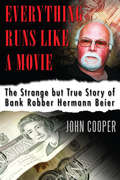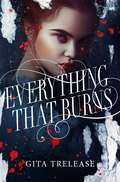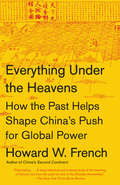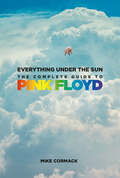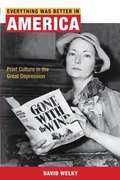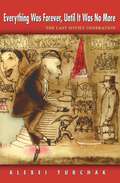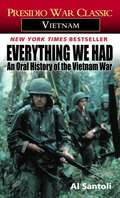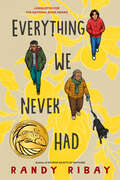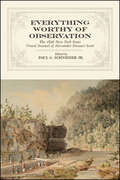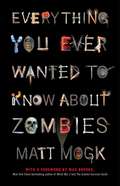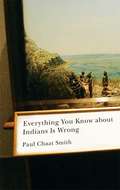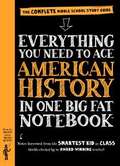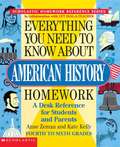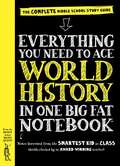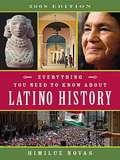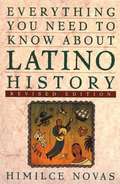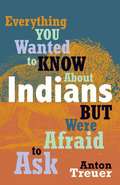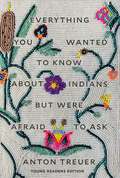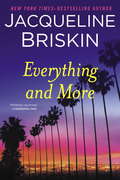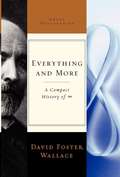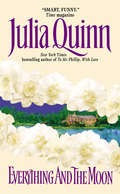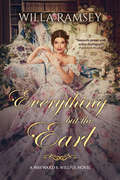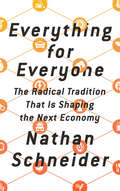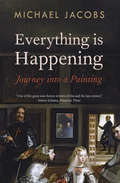- Table View
- List View
Everything Runs Like a Movie: The Strange but True Story of Bank Robber Hermann Beier
by John CooperA true story of a bank robber and a chilling car chase worthy of an Elmore Leonard novel or a Brian De Palma movie. Like many new arrivals to Canada, Hermann Beier came to this country with big dreams – visions of a wide-open country where hard work and entrepreneurial flair would make him rich. A charismatic handyman, martial arts teacher, and small business owner, he charmed women and earned the respect of men. He was loved in his community of Alliston, Ontario, and had a plan to make a million bucks. But when those dreams soured, Beier turned to crime to pay the bills. Faced with bankruptcy in 1991, Beier hatched a plan to rob a string of banks in a single day. But it was all too much, too fast. After leading authorities from Guelph to Caledon on what was then the longest police chase in Canadian history, Beier was gunned down alongside a farmer’s fence, his body pierced by a hail of police bullets. But he survived, and the end of his crime spree marked a new beginning. After spending almost a decade in various Ontario prisons, searching for a way to get his life back on track, Beier was finally paroled. He now lives a quiet life, dividing his time between Canada and Austria.
Everything That Burns (Enchantée #2)
by Gita TreleaseGita Trelease's Everything That Burns is the transporting sequel to All That Glitters, hailed by NPR as a “soaring success”! Camille Durbonne gambled everything she had to keep herself and her sister safe. But as the people of Paris starve and mobs riot, safety may no longer be possible......Not when Camille lives for the rebellion. In the pamphlets she prints, she tells the stories of girls living at society’s margins. But as her writings captivate the public, she begins to suspect a dark magic she can’t control lies at the heart of her success. Then Louis XVI declares magic a crime and all magicians traitors to France. As bonfires incinerate enchanted books and special police prowl the city, the time for magic—and those who work it—is running out.In this new Paris where allegiances shift and violence erupts, the answers Camille seeks set her on a perilous path, one that may cost her the boy she loves—even her life. If she can discover who she truly is before vengeful forces unmask her, she may still win this deadly game of revolution.
Everything Under the Heavens: How the Past Helps Shape China's Push for Global Power
by Howard W. FrenchFrom the former New York Times Asia correspondent and author of China's Second Continent, an incisive investigation of China's ideological development as it becomes an ever more aggressive player in regional and global diplomacy. For many years after its reform and opening in 1978, China maintained an attitude of false modesty about its ambitions. That role, reports Howard French, has been set aside. China has asserted its place among the global heavyweights, revealing its plans for pan-Asian dominance by building its navy, increasing territorial claims to areas like the South China Sea, and diplomatically bullying smaller players. Underlying this attitude is a strain of thinking that casts China's present-day actions in decidedly historical terms, as the path to restoring the dynastic glory of the past. If we understand how that historical identity relates to current actions, in ways ideological, philosophical, and even legal, we can learn to forecast just what kind of global power China stands to become--and to interact wisely with a future peer. Steeped in deeply researched history as well as on-the-ground reporting, this is French at his revelatory best.From the Hardcover edition.
Everything Under the Sun: The Complete Guide to Pink Floyd
by Mike CormackPink Floyd are one of the most iconic and influential rock bands in the world: their sonic ambition, lyrical dexterity and structural ability are unparalleled in rock music. Since their formation in 1965, they have released 15 studio albums and sold over 250 million records. Their eighth album, Dark Side of the Moon, is one of the highest-selling British albums in the world.Mike Cormack takes a deep dive into the music of Pink Floyd, resulting in the first serious appraisal of the band’s immense achievements, whilst also giving an overview of the UK’s concurrent social and political history as seen through the prism of the band. In addition to a song-by-song analysis, Mike also shares exclusive band interviews, a full chronology and gig guide, and a full bootleg guide.Everything Under the Sun is the definitive account of the career of rock’s most devastatingly emotional and articulate band.
Everything Was Better in America: Print Culture in the Great Depression
by David WelkyAs a counterpart to research on the 1930s that has focused on liberal and radical writers calling for social revolution, David Welky offers this eloquent study of how mainstream print culture shaped and disseminated a message affirming conservative middle-class values and assuring its readers that holding to these values would get them through hard times. Through analysis of the era's most popular newspaper stories, magazines, and books, Welky examines how voices both outside and within the media debated the purposes of literature and the meaning of cultural literacy in a mass democracy. He presents lively discussions of such topics as the newspaper treatment of the Lindbergh kidnapping, issues of race in coverage of the 1936 Olympic games, domestic dynamics and gender politics in cartoons and magazines, Superman's evolution from a radical outsider to a spokesman for the people, and the popular consumption of such novels as the Ellery Queen mysteries, Gone with the Wind, and The Good Earth. Through these close readings, Welky uncovers the subtle relationship between the messages that mainstream media strategically crafted and those that their target audience wished to hear.
Everything Was Forever, Until It Was No More: The Last Soviet Generation (In-Formation)
by Alexei YurchakSoviet socialism was based on paradoxes that were revealed by the peculiar experience of its collapse. To the people who lived in that system the collapse seemed both completely unexpected and completely unsurprising. At the moment of collapse it suddenly became obvious that Soviet life had always seemed simultaneously eternal and stagnating, vigorous and ailing, bleak and full of promise. Although these characteristics may appear mutually exclusive, in fact they were mutually constitutive. This book explores the paradoxes of Soviet life during the period of "late socialism" (1960s-1980s) through the eyes of the last Soviet generation. Focusing on the major transformation of the 1950s at the level of discourse, ideology, language, and ritual, Alexei Yurchak traces the emergence of multiple unanticipated meanings, communities, relations, ideals, and pursuits that this transformation subsequently enabled. His historical, anthropological, and linguistic analysis draws on rich ethnographic material from Late Socialism and the post-Soviet period. The model of Soviet socialism that emerges provides an alternative to binary accounts that describe that system as a dichotomy of official culture and unofficial culture, the state and the people, public self and private self, truth and lie--and ignore the crucial fact that, for many Soviet citizens, the fundamental values, ideals, and realities of socialism were genuinely important, although they routinely transgressed and reinterpreted the norms and rules of the socialist state.
Everything We Had: An Oral History of the Vietnam War
by Al SantoliHere is an oral history of the Vietnam War by thirty-three American soldiers who fought it. A 1983 American Book Award nominee.
Everything We Never Had
by Randy RibayWinner of the Asian/Pacific American Award for LiteratureLonglisted for the National Book AwardFrom the author of the National Book Award finalist Patron Saints of Nothing comes an emotionally charged, moving novel about four generations of Filipino American boys grappling with identity, masculinity, and their fraught father-son relationships.Watsonville, 1930. Francisco Maghabol barely ekes out a living in the fields of California. As he spends what little money he earns at dance halls and faces increasing violence from white men in town, Francisco wonders if he should&’ve never left the Philippines.Stockton, 1965. Between school days full of prejudice from white students and teachers and night shifts working at his aunt&’s restaurant, Emil refuses to follow in the footsteps of his labor organizer father, Francisco. He&’s going to make it in this country no matter what or who he has to leave behind.Denver, 1983. Chris is determined to prove that his overbearing father, Emil, can&’t control him. However, when a missed assignment on &“ancestral history&” sends Chris off the football team and into the library, he discovers a desire to know more about Filipino history―even if his father dismisses his interest as unamerican and unimportant.Philadelphia, 2020. Enzo struggles to keep his anxiety in check as a global pandemic breaks out and his abrasive grandfather moves in. While tensions are high between his dad and his lolo, Enzo&’s daily walks with Lolo Emil have him wondering if maybe he can help bridge their decades-long rift.Told in multiple perspectives, Everything We Never Had unfolds like a beautifully crafted nesting doll, where each Maghabol boy forges his own path amid heavy family and societal expectations, passing down his flaws, values, and virtues to the next generation, until it&’s up to Enzo to see how he can braid all these strands and men together.
Everything Worthy of Observation: The 1826 New York State Travel Journal of Alexander Stewart Scott (Excelsior Editions)
by Paul G. Schneider Jr.Finalist for the 2019 Foreword INDIES Book of the Year Award in the History categoryIn the pre-dawn of August 2, 1826, Alexander Stewart Scott stepped aboard the steamboat Chambly in Quebec City, Canada. He was beginning a journey that not only took him across New York State but also ultimately changed his view of America and her people. A keen observer, the twenty-one-year-old meticulously recorded his travel experiences, observations about the people he encountered, impressions of things he saw, and reactions to events he witnessed.This firsthand account immerses the reader in the world of early-nineteenth-century life in both New York and Lower Canada. Whether enduring the choking dust raised by a stagecoach, the frustration and delays caused by bad roads, or the wonders and occasional dangers of packet boat travel on the newly completed Erie Canal, all are vividly brought to life by Scott's pen. This journal also offers a unique blend of travel and domestic insights. With close family members living in both St. John's, Quebec, Canada, and Palmyra, New York, his travels were supplemented by long stays in these communities, offering readers comparative glimpses into the daily lives and activities in both countries. Gregarious, funny, and inquisitive, Scott missed nothing of what he thought worthy of observation.
Everything You Ever Wanted to Know About Zombies
by Matt MogkThe most comprehensive zombie handbook ever published--with a foreword by Max Brooks! In one indispensable volume, Matt Mogk busts popular myths and answers all your raging questions about the living dead.*Q. How can I increase my chances of survival? A. One simple step is to keep away from other people. Without people there can be no zombies. Q. What is the connection between the Voodoo zombie and the flesh-eating zombie of popular culture? A. Other than a shared name, absolutely nothing. Q. Will zombies actually eat me, or will they just bite and chew? A. Research suggests the neuromuscular activity required for swallowing may be too complex for a zombie. Q. Will we see any warning signs before the dead rise? A. Unfortunately, entire populations could be infected with the zombie sickness before anyone even knows there's a problem. Q. How come Zombie Awareness Month is in May and not October? A. Unlike witches and vampires, zombies are not otherworldly creatures. They are made of flesh and blood. Don't forget to wear your gray ribbon. * Many more questions about zombies--including why not all of them are undead--are answered inside the book.
Everything You Ever Wanted to Know About Zombies
by Matt MogkTHE MOST COMPREHENSIVE ZOMBIE HANDBOOK EVER PUBLISHED In one indispensable volume, Matt Mogk, founder and head of the Zombie Research Society, busts popular myths and answers all your raging questions about the living dead.* Q. How can I increase my chances of survival? A. One simple step is to keep away from other people. Without people there can be no zombies. Q. What is the connection between the Voodoo zombie and the flesh-eating zombie of popular culture? A. Other than a shared name, absolutely nothing. Q. Will zombies actually eat me, or will they just bite and chew? A. Research suggests the neuromuscular activity required for swallowing may be too complex for a zombie. Q. Will we see any warning signs before the dead rise? A. Unfortunately, entire populations could be infected with the zombie sickness before anyone even knows there's a problem. Q. How come Zombie Awareness Month is in May and not October? A. Unlike witches and vampires, zombies are not otherworldly creatures. They are made of flesh and blood. Don't forget to wear your gray ribbon. * Many more questions about zombies--including why not all of them are undead--are answered inside the book.
Everything You Know About Indians Is Wrong (Indigenous Americas)
by Paul Chaat SmithIn this sweeping work of memoir and commentary, leading cultural critic Paul Chaat Smith illustrates with dry wit and brutal honesty the contradictions of life in “the Indian business.” <p><p> Raised in suburban Maryland and Oklahoma, Smith dove head first into the political radicalism of the 1970s, working with the American Indian Movement until it dissolved into dysfunction and infighting. Afterward he lived in New York, the city of choice for political exiles, and eventually arrived in Washington, D.C., at the newly minted National Museum of the American Indian (“a bad idea whose time has come”) as a curator. In his journey from fighting activist to federal employee, Smith tells us he has discovered at least two things: there is no one true representation of the American Indian experience, and even the best of intentions sometimes ends in catastrophe. <p> Everything You Know about Indians Is Wrong is a highly entertaining and, at times, searing critique of the deeply disputed role of American Indians in the United States. In “A Place Called Irony,” Smith whizzes through his early life, showing us the ironic pop culture signposts that marked this Native American's coming of age in suburbia: “We would order Chinese food and slap a favorite video into the machine—the Grammy Awards or a Reagan press conference—and argue about Cyndi Lauper or who should coach the Knicks.” In “Lost in Translation,” Smith explores why American Indians are so often misunderstood and misrepresented in today's media: “We're lousy television.” In “Every Picture Tells a Story,” Smith remembers his Comanche grandfather as he muses on the images of American Indians as “a half-remembered presence, both comforting and dangerous, lurking just below the surface.” <p> Smith walks this tightrope between comforting and dangerous, offering unrepentant skepticism and, ultimately, empathy. “This book is called Everything You Know about Indians Is Wrong, but it's a book title, folks, not to be taken literally. Of course I don't mean everything, just most things. And 'you' really means we, as in all of us.”
Everything You Need To Ace American History In One Big Fat Notebook
by Philip BiglerEverything You Need to Ace American History covers Native Americans to the war in Iraq. There are units on Colonial America; the Revolutionary War and the founding of a new nation; Jefferson and the expansion west; the Civil War and Reconstruction; and all of the notable events of the 20th century--World Wars, the Depression, the Civil Rights movement, and much more. The BIG FAT NOTEBOOK(tm) series is built on a simple and irresistible conceit--borrowing the notes from the smartest kid in class. There are five books in all, and each is the only book you need for each main subject taught in middle school: Math, Science, American History, English Language Arts, and World History. Inside the reader will find every subject's key concepts, easily digested and summarized: Critical ideas highlighted in neon colors. Definitions explained. Doodles that illuminate tricky concepts in marker. Mnemonics for memorable shortcuts. And quizzes to recap it all. The BIG FAT NOTEBOOKS meet Common Core State Standards, Next Generation Science Standards, and state history standards, and are vetted by National and State Teacher of the Year Award-winning teachers. They make learning fun, and are the perfect next step for every kid who grew up on Brain Quest.
Everything You Need To Know About American History Homework
by Kate Kelly Anne Zeman Anne M. ZemanProvides fourth to sixth grade students and their parents with information they need to complete American history assignments. Includes information about such topics as the Declaration of Independence, the Westward expansion, the Transcontinental Railroad, important inventions, and much more.
Everything You Need to Ace World History in One Big Fat Notebook: The Complete Middle School Study Guide (Big Fat Notebooks)
by Ximena Vengoechea Michael LindbladEverything You Need to Ace World History . . . kicks off with the Paleolithic Era and transports the reader to ancient civilizations--from Africa and beyond; the middle ages across the world; the Renaissance; the age of exploration and colonialism, revolutions, and the modern world and the wars and movements that shaped it. <p><p> The BIG FAT NOTEBOOKS meet Common Core State Standards, Next Generation Science Standards, and state history standards, and are vetted by National and State Teacher of the Year Award–winning teachers. They make learning fun, and are the perfect next step for every kid who grew up on Brain Quest.
Everything You Need to Know About Latino History
by Himilce NovasThe popular primer to Latino life and culture?updated for 2008 Latinos represent the fastest-growing ethnic population in the United States. In an accessible and entertaining question-and-answer format, this completely revised 2008 edition provides the most current perspective on Latino history in the making, including: ? New Mexico governor Bill Richardson?s announced candidacy for the 2008 presidential election ? Ugly Betty?the hit ABC TV show based on the Latino telenovela phenomenon ? The number of Latino players in Major League baseball surpassing the 25 percent mark ? Immigration legislation and the battle over the Mexican border ? The state of Castro?s health and what it means for Cuba More than ever, this concise yet comprehensive reference guide is the ideal introduction to the vast and varied history and culture of this multifaceted ethnic group. .
Everything You Need to Know about Latino History
by Himilce NovasIf you eat fajitas, listen to Selena, have studied the Spanish-American War, read Julia Alvarez, visited Miami, or seen Charlie Sheen in a movie, you're probably aware that Latino culture is an integral part of American life. But most Americans do not know much about Latino history, or realize the impact it has on the politics, economy, and culture of American life. <P>"Everything You Need to Know About Latino History" covers the contributions of Spaniards, Mexicans, Puerto Ricans, Cubans, Dominicans, and Central and South Americans whose cultures have given us everything from chocolate to chili peppers, from mambo to machismo, and from Desi Arnaz to Oscar Hijuelos. Presented in a question and answer format, this revised edition includes new information on Central and South Americans, the largest group of new Latino immigrants, the passing of Proposition 187 in California, and how Latino women are playing a larger role in politics and the arts. This accessible reference book is perfect for boththe history buff and the curious reader who want to learn more about Latino American history.
Everything You Wanted To Know About Indians But Were Afraid To Ask
by Anton TreuerIn matter-of-fact responses to over 120 questions, both thoughtful and outrageous, modern and historical, Ojibwe scholar and cultural preservationist Anton Treuer gives a frank, funny, and sometimes personal tour of what's up with Indians, anyway. --What is the real story of Thanksgiving? --Why are tribal languages important? --What do you think of that incident where people died in a sweat lodge? White/Indian relations are often characterized by guilt and anger. Everything You Wanted to Know about Indians but Were Afraid to Ask cuts through the emotion and builds a foundation for true understanding and positive action.
Everything You Wanted to Know About Indians But Were Afraid to Ask: Young Readers Edition
by Anton TreuerNow in paperback! An essential book of questions and answers for Native and non-Native young readers alike. Ranging from “Why is there such a fuss about nonnative people wearing Indian costumes for Halloween?” to “Why is it called a ‘traditional Indian fry bread taco’?“ to “What’s it like for natives who don’t look native?” to “Why are Indians so often imagined rather than understood?”, and beyond, Everything You Wanted to Know About Indians But Were Afraid to Ask (Young Readers Edition) does exactly what its title says for young readers, in a style consistently thoughtful, personal, and engaging. Updated and expanded to include: * Dozens of New Questions and New Sections—including a social activism section that explores the Dakota Access Pipeline, racism, identity, politics, and more! * Over 50 new Photos * Adapted text for broad appeal P R A I S E Best of the Year: Chicago Public Library * Kirkus * Cooperative Children's Book Center “A wide-ranging compendium of provocative questions and satisfying answers. Perfect for browsing or a deep dive.”—San Francisco Chronicle ★ “Wise, well-researched, and not to be missed. This collection of short essays about Native Americans is comprehensive, equitable, and generous.” —Kirkus (starred) ★ “Reading this book is like enjoying a talk with a close relative who wants you to learn, grow, and continue to ask questions. This book is an important resource about contemporary North American Indigenous peoples. Recommend for all libraries.”—School Library Journal (starred) “An excellent resource that should be in every middle and high school.”—School Library Connection “A personal, reflective, yet thoroughly grounded take on the present as well as the past, and it’s a great starting place for young readers beginning to ask these exact questions.” —Bulletin of the Center for Children's Books
Everything and More
by Jacqueline BriskinTwo sisters--the beautiful and alluring Marilyn, and her smart and savvy sister, Roy--move to Beverly Hills with their mother after the death of their father, so that they can attend the posh public school Beverly Hills High. Though they live in relative poverty, Marilyn acts in all of the school plays at her mother's insistence, and she is quickly noticed by Linc, the oldest son of the iconic movie producer Joshua Fernauld. Marilyn and Linc find themselves overtaken by a passionate romance that neither of them had expected, and they are devastated when Linc, who is in the air force, is called back to duty overseas. Marilyn's acute loss continues to haunt her for years afterward when she and Linc suffer a tragedy worse than she had ever imagined.Meanwhile, Roy graduates from high school and goes on to pursue her interest in fashion, becoming a successful businesswoman at an upscale boutique. Her closest friend from Beverly Hills High, Althea, is a wealthy and mysterious beauty, whose sharp remarks and unfailing composure hide dark and terrible secrets about her family life. Throughout their childhood, Althea is generous to Roy but deeply possessive of her. As the pair grows older, Althea's antics worsen until the two find themselves embroiled in a love triangle with an artist named Gerry Horak, which threatens to tear them apart once and for all.An epic tale that spans continents and nearly half a century, Everything and More is a suspenseful tour de force by a master at family drama. Readers will be hooked from the first page and surprised throughout by the passion, trickery, and emotion culminating in a shocking twist that no one ever saw coming.
Everything and More: A Compact History of Infinity
by David Foster WallaceDavid Wallace brings his intellectual ambition to the story of how mathematicians have understood the infinite, from the ancient Greeks to the nineteenth-century mathematical genius Cantor's discovery that there is more than one kind of infinity.
Everything and the Moon (Lyndon Sisters #1)
by Julia QuinnIt was indisputably love at first sight. But Victoria Lyndon was merely the teenaged daughter of a vicar. . .while Robert Kemble was the dashing young earl of Macclesfield. Surely what their meddlesome fathers insisted must have been true-that he was a reckless seducer determined to destroy her innocence. . . and she was a shameless fortune hunter. So it most certainly was for the best when their plans to elope went hopelessly awry. Even after a seven-year separation, Victoria-now a governess-still leaves Robert breathless. But how could he ever again trust the raven-haired deceiver who had shattered his soul? And Victoria could never give her heart a second time to the cad who so callously trampled on it the first. But a passion fated will not be denied, and vows of love yearn to be kept. . . even when one promises the moon.
Everything but the Earl (A Wayward & Willful Novel #1)
by Willa RamseySome loutish lords are about to learn how to treat a lady: &“Witty dialogue…enjoyable reading.&”—Publishers Weekly Miss Caroline Crispin is on top of the world. But she&’s about to take a painful fall… As the daughter of London&’s most in-demand architect, Caro has laughed and danced and pursued her interests with gusto—free from Society&’s censure. So when she overhears two lords calling her vulgar names and wagering on whose lover she&’ll become, she&’s shocked and stung—and determined to teach them a lesson. Though it pains her to ask for help from another brutish lord…Lord Ryland isn&’t the man his father wanted him to be. But he&’s about to make an excellent catch... Adam, Earl Ryland, just wants to get married and tend his country garden, away from the bucks, fops, and gossips who pester him to box like his late father. When this gentle giant meets his sister&’s friend Caro—who parries his flirtations with double entendre that would make a barman blush—he&’s smitten. But there&’s a problem: she&’s looking to him for a different sort of partnership. And it&’s a risky one… &“Everything But the Earl has everything you could want in a Regency romp.&”—Elizabeth Essex, award-winning author of the Reckless Brides series
Everything for Everyone: The Radical Tradition That Is Shaping the Next Economy
by Nathan SchneiderThe origins of the next radical economy is rooted in a tradition that has empowered people for centuries and is now making a comeback.A new feudalism is on the rise. While monopolistic corporations feed their spoils to the rich, more and more of us are expected to live gig to gig. But, as Nathan Schneider shows, an alternative to the robber-baron economy is hiding in plain sight; we just need to know where to look.Cooperatives are jointly owned, democratically controlled enterprises that advance the economic, social, and cultural interests of their members. They often emerge during moments of crisis not unlike our own, putting people in charge of the workplaces, credit unions, grocery stores, healthcare, and utilities they depend on.Everything for Everyone chronicles this revolution--from taxi cooperatives keeping Uber at bay, to an outspoken mayor transforming his city in the Deep South, to a fugitive building a fairer version of Bitcoin, to the rural electric co-op members who are propelling an aging system into the future. As these pioneers show, co-ops are helping us rediscover our capacity for creative, powerful, and fair democracy.
Everything is Happening: Journey into a Painting
by Michael JacobsA fascinating journey through a single painting&’s history, meanings and associations by &“one of the great non-fiction writers of this and the last century&” (Simon Schama, Financial Times).Acclaimed travel author and art historian Michael Jacobs was haunted by Velázquez&’s enigmatic masterpiece Las Meninas from first encountering it in the Prado as a teenager. In Everything is Happening Jacobs searches for the ultimate significance of the painting by following the many associations suggested by each of its characters, as well as his own relationship to the work.From Jacobs&’ first trip to Spain to the politics of Golden Age Madrid, to his meeting with the man who saved Las Meninas during the Spanish Civil war, to his experiences in the sunless world of the art history academy, Jacobs delivers a brilliantly discursive meditation on art and life that dissolves the barriers between the past and the present, the real and the illusory. Cut short by Jacobs&’ death in 2014, and completed with an introduction and coda by his friend and fellow art lover, the journalist Ed Vulliamy, this visionary and often very funny book is a passionate, personal manifesto for the liberation of how we look at painting.
